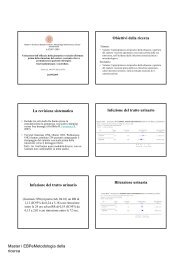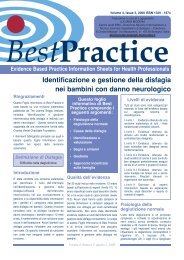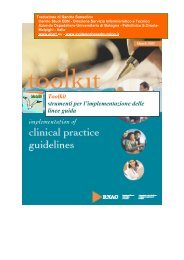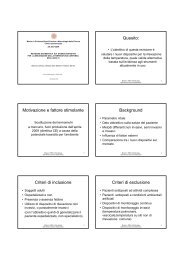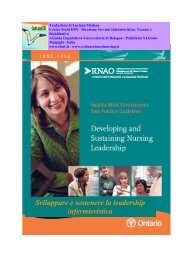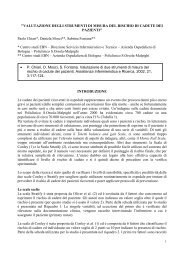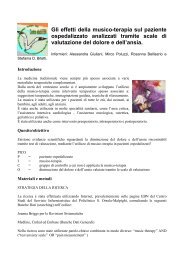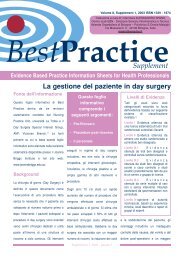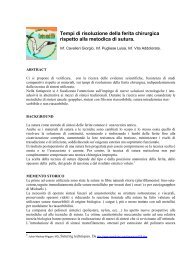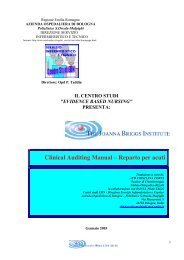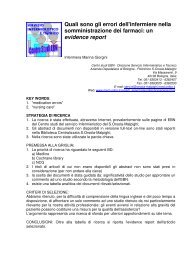La presa in carico del paziente con frattura - Evidence Based Nursing
La presa in carico del paziente con frattura - Evidence Based Nursing
La presa in carico del paziente con frattura - Evidence Based Nursing
You also want an ePaper? Increase the reach of your titles
YUMPU automatically turns print PDFs into web optimized ePapers that Google loves.
Regione Emilia Romagna<br />
AZIENDA OSPEDALIERO-UNIVERSITARIA DI BOLOGNA<br />
Policl<strong>in</strong>ico S. Orsola-Malpighi<br />
DIREZIONE DEL SERVIZIO INFERMIERISTICO,<br />
TECNICO E RIABILITATIVO<br />
Centro Studi EBN<br />
Area Governo Cl<strong>in</strong>ico<br />
<strong>Evidence</strong> <strong>Based</strong> Phisyotherapy<br />
<strong>La</strong> <strong>presa</strong> <strong>in</strong> <strong>carico</strong> <strong>del</strong> <strong>paziente</strong><br />
<strong>con</strong> <strong>frattura</strong> di femore e/o protesi d’anca.<br />
2007<br />
Ricercatore EBN<br />
Simona Br<strong>in</strong>i<br />
Gruppo di lavoro<br />
<strong>La</strong>ura Balbi<br />
Moreno Balboni<br />
Brunella Brighi<br />
Franca Capatti<br />
Carlo Capponcelli<br />
Manuela Mezzetti<br />
<strong>La</strong>ura Montali<br />
C<strong>in</strong>zia Russillo
<strong>La</strong> <strong>presa</strong> <strong>in</strong> <strong>carico</strong> <strong>del</strong> <strong>paziente</strong> <strong>con</strong> <strong>frattura</strong> di femore e/o protesi d’anca<br />
** Br<strong>in</strong>i S.; * Balbi L.; * Balboni M.; * Brighi B.; * Capatti F.; * Capponcelli C.; * Mezzetti M.;<br />
* Montali L.; * Russillo C.<br />
** Fisioterapista-Ricercatore EBN, * Fisioterapista<br />
Introduzione<br />
Il programma riabilitativo co<strong>in</strong>volge il <strong>paziente</strong> dall’immediato postoperatorio alla<br />
dimissione.<br />
A questo proposito la letteratura raccomanda che la <strong>presa</strong> <strong>in</strong> <strong>carico</strong> avvenga il più precocemente<br />
possibile, entro 24 – 48 ore dal giorno <strong>del</strong>l’<strong>in</strong>tervento 1 2 che è def<strong>in</strong>ito giorno 0.<br />
E’ dimostrato che una precoce valutazione da parte <strong>del</strong> Team <strong>in</strong>terprofessionale, di cui il<br />
fisioterapista è parte <strong>in</strong>tegrante, <strong>con</strong>sente la formulazione di una basel<strong>in</strong>e <strong>del</strong> progetto prelim<strong>in</strong>are di<br />
riabilitazione e di facilitare la riabilitazione e la dimissione <strong>del</strong> <strong>paziente</strong> 3 4 5 . (SIGN - Livello di<br />
evidenza 2+)<br />
Elementi predittivi <strong>del</strong>l’esito <strong>del</strong>la riabilitazione sono lo stato mentale, la mobilità e la<br />
funzionalità <strong>del</strong> <strong>paziente</strong> prima <strong>del</strong>l’<strong>in</strong>fortunio che possono essere utilizzati come parametri per<br />
valutare il tipo di programma riabilitativo da impostare e <strong>in</strong>dividuare le potenzialità da sfruttare<br />
9 . (SIGN - Livello di evidenza 2++)<br />
Attualmente non è stata ancora identificata una scala di valutazione da utilizzare durante la<br />
degenza postoperatoria ma l’Index of Independence <strong>in</strong> Activities of Daily Liv<strong>in</strong>g di Katz (Index of<br />
ADL o Katz Index) 10 fornisce uno strumento di misura <strong>del</strong>l’<strong>in</strong>dipendenza funzionale nelle attività di<br />
base <strong>del</strong>la vita quotidiana ideato per valutare la prognosi e l’efficacia <strong>del</strong> trattamento nei soggetti<br />
anziani e nei malati cronici (<strong>in</strong> orig<strong>in</strong>e quelli affetti da stroke, <strong>frattura</strong> femore o artrite reumatoide)<br />
ospedalizzati e ambulatoriali.<br />
L’<strong>in</strong>dice di Katz valuta la capacità di compiere sei attività, che <strong>con</strong>sentono il<br />
soddisfacimento di bisogni fisiologici e di sicurezza fondamentali per la persona e la cui<br />
compromissione determ<strong>in</strong>a uno stato di dipendenza funzionale. Il risultato ha valore predittivo per<br />
l’ospedalizzazione, la durata <strong>del</strong>la degenza ospedaliera, la necessità di assistenza domiciliare, di<br />
ammissione <strong>in</strong> RSA e la mortalità.<br />
1 Scottish Intercollegiate Gui<strong>del</strong><strong>in</strong>e Network (SIGN-2002 n°56): “Prevention and Management of hip fracture <strong>in</strong> older<br />
People. A national cl<strong>in</strong>ical gui<strong>del</strong><strong>in</strong>e”.<br />
2 Best Practice <strong>Evidence</strong> <strong>Based</strong> Gui<strong>del</strong><strong>in</strong>e. (2003) “Acute management and immediate Rehabilitation after Hip Fracture<br />
amongst people aged 65 years and over”. New Zealand Gui<strong>del</strong><strong>in</strong>es Group.<br />
3 Parker MJ, Pryor GA, Myles JW. (1991): Early discharge after hip fracture. Prospective 3-year study of 645 patients.<br />
Acta Orthop Scand; 62: 563-6<br />
4 O'Catha<strong>in</strong> A. (1994): Evaluation of a Hospital at Home scheme for the early discharge of patients with fractured neck<br />
of femur. J Pub Health Med; 16: 205-10<br />
5 Scottish Intercollegiate Gui<strong>del</strong><strong>in</strong>e Network. (SIGN-2002 n°56): Op.Cit. Section 9: Rehabilitation and discharge<br />
6 Ensberg M, Paletta J, Galecki AT, Dacko CL, Fries BE. (1993): Identify<strong>in</strong>g elderly patients for early discharge after<br />
hospitalisation for hip fracture. J Gerontol A Biol Sci Med Sci; 48: 187-95<br />
7 Goldste<strong>in</strong> F, Strasser D, Woodard J, Roberts VJ. (1997): Functional outcome of cognitively impaired hip fracture<br />
patients on a geriatric rehabilitation unit. J Am Geriatr Soc; 45: 35-42<br />
8 Pryor GA, Williams DR. (1989): Rehabilitation after hip fractures. Home and hospital management compared. J Bone<br />
Jo<strong>in</strong>t Surg Br; 71: 471-4<br />
9 Heruti RJ, Lusky A, Barell V, Ohry A, Adunsky A. (1999): Cognitive status at admission: does it affect the<br />
rehabilitation outcome of elderly patients with hip fracture? Arch Phys Med Rehabil; 80: 432-6.<br />
10 Katz S, Ford AB, Moskowitz RW, et al. (1963): Studies of illness <strong>in</strong> the aged. The Index of ADL: a standardized<br />
measure of biological and psychosocial function. JAMA; 185:914-919<br />
6 7 8
Il programma riabilitativo, rivolto al <strong>paziente</strong> operato per <strong>frattura</strong> di femore, deve<br />
svilupparsi tenendo <strong>in</strong> debito <strong>con</strong>to la molteplicità di problemi che spesso <strong>con</strong>traddist<strong>in</strong>guono la<br />
persona anziana che subisce questo tipo di trauma.<br />
Inizialmente l’enfasi maggiore va posta sul riprist<strong>in</strong>o <strong>del</strong>la deambulazione e <strong>del</strong>l’attività<br />
<strong>del</strong>la vita quotidiana (ADL) come ad esempio i trasferimenti, la possibilità di vestirsi e di occuparsi<br />
<strong>del</strong>la propria igiene personale. L’equilibrio e le abilità deambulatorie sono elementi predittivi per la<br />
valutazione <strong>del</strong>l’<strong>in</strong>dipendenza funzionale alla quale il programma riabilitativo tende11 12 . (SIGN -<br />
Livello d’evidenza 2++).<br />
L’obiettivo è quello di permettere al <strong>paziente</strong> il rientro al proprio domicilio nelle migliori<br />
<strong>con</strong>dizioni di sicurezza e d’<strong>in</strong>dipendenza compatibilmente <strong>con</strong> le limitazioni temporanee legate al<br />
tipo d’<strong>in</strong>tervento chirurgico subito, alle <strong>in</strong>dicazioni di <strong>carico</strong> e all’utilizzo d’ausili.<br />
Il programma riabilitativo che preveda esercizi che aumentano la resistenza fisica ed<br />
amplificano la funzionalità è sufficientemente efficace per migliorare la forma fisica e le prestazioni<br />
<strong>del</strong>l’anziano che ha subito la <strong>frattura</strong> <strong>del</strong> femore. Inoltre un addestramento <strong>con</strong> queste<br />
caratteristiche permette di prevenire ulteriori cadute e relative <strong>con</strong>seguenze negative 13 .<br />
<strong>La</strong> precocità <strong>del</strong>l’<strong>in</strong>tervento riabilitativo, trova <strong>in</strong>dicazione14 per <strong>con</strong>trastare i rischi correlati<br />
all’<strong>in</strong>tervento chirurgico e all’immobilizzazione di pazienti anziani, come le piaghe da decubito e la<br />
Trombosi Venosa Profonda15 , ed <strong>in</strong>oltre per <strong>con</strong>tenere le complicazioni polmonari16 .<br />
In questa fase è importante <strong>con</strong>siderare tutti quegli elementi preesistenti che possono<br />
<strong>in</strong>fluenzare lo sviluppo e l’esito <strong>del</strong> programma riabilitativo17 come ad esempio le patologie<br />
<strong>con</strong>comitanti, i deficit <strong>del</strong>la deambulazione e <strong>del</strong>l’equilibrio, le dim<strong>in</strong>uite capacità visive e motorie,<br />
il deterioramento cognitivo18 . Va sottol<strong>in</strong>eato che le capacità cognitive e collaborative <strong>del</strong> <strong>paziente</strong><br />
possono <strong>in</strong>fluire <strong>in</strong> modo determ<strong>in</strong>ate sul programma riabilitativo19 .<br />
A questi elementi se ne aggiungono altri che sono legati alla fase postchirurgica e sono le<br />
<strong>con</strong>dizioni di salute generali, il tipo di <strong>frattura</strong> subita e <strong>con</strong>seguentemente il tipo di <strong>in</strong>tervento a cui a<br />
stato sottoposto.<br />
<strong>La</strong> collaborazione tra tutti i membri <strong>del</strong> team mulidiscipl<strong>in</strong>are è un valido aiuto sia per la<br />
gestione cl<strong>in</strong>ica <strong>del</strong> <strong>paziente</strong> anziano, che per una facilitazione <strong>del</strong> processo riabilitativo. L’unione<br />
di <strong>in</strong>tenti tende ad ottenere una precoce <strong>in</strong>dipendenza funzionale, la riduzione <strong>del</strong>l’allettamento, la<br />
formulazione di un <strong>in</strong>tervento personalizzato e una riduzione di future ospedalizzazioni,<br />
20 21 22 23 24 25 26<br />
<strong>con</strong>siderando anche la possibilità di organizzare un’adeguata assistenza domiciliare<br />
11 Ensberg M, Paletta J, Galecki AT, Dacko CL, Fries BE. (1993): Identify<strong>in</strong>g elderly patients for early discharge after<br />
hospitalisation for hip fracture. J Gerontol A Biol Sci Med Sci; 48: 187-95.<br />
12 Fox KM, Hawkes WG, Hebel JR, Felsenthal G, Clark M, Zimmerman SI, et al. (1998): Mobility after hip fracture<br />
predicts health outcomes. J Am Geriatr Soc; 46: 169-73<br />
13 Hauer K, Rost B, Rutschle K et al. (2001): Exercise tra<strong>in</strong><strong>in</strong>g for rehabilitation and se<strong>con</strong>dary prevention of falls <strong>in</strong><br />
geriatric patients with a history of <strong>in</strong>jurious falls. J Am Geriatric Soc; 49: 10-20<br />
14 Scottish Intercollegiate Gui<strong>del</strong><strong>in</strong>e Network. (SIGN-2002 n°56): Op.Cit. Section 8 Early postoperative management.<br />
8.4 Early mobilisation 24<br />
15 Antonelli Incalzi R, Gemma A, Capparella O, Terranova L, Sangu<strong>in</strong>etti C, Carbon<strong>in</strong> PU. (1993): Post-operative<br />
electrolyte imbalance: its <strong>in</strong>cidence and prognostic implications for elderly orthopaedic patients. Age Age<strong>in</strong>g; 22:<br />
325-31<br />
16 McKenzie PJ. In: Loach AB (Editor). Orthopaedic Anaesthesia. London: Edward Arnold, 1994: 159-67.<br />
17 Scottish Intercollegiate Gui<strong>del</strong><strong>in</strong>e Network. (SIGN-2002 n°56): Op.Cit. Section 9.1 Early assessment<br />
18 Heruti RJ, Lusky A, Barell V, Ohry A, Adunsky A. Cognitive status at admission: does it affect the rehabilitation<br />
outcome of elderly patients with hip fracture? Arch Phys Med Rehabil 1999; 80: 432-6.<br />
19 Fox KM, Hawkes WG, Hebel JR, Felsenthal G, Clark M, Zimmerman SI, et al. (1998): Mobility after hip fracture<br />
predicts health outcomes. J Am Geriatr Soc; 46: 169-73.<br />
20 Cameron ID, Lyle DM, Qu<strong>in</strong>e S. (1993): Accelerated rehabilitation after proximal femoral fracture: a randomised<br />
<strong>con</strong>trolled trial. Disabil Rehabil; 15: 29-34<br />
21 Farnworth MG, Kenny P, Shiell A. (1994): The costs and effects of early discharge <strong>in</strong> the management of fractured<br />
hip. Age and Age<strong>in</strong>g; 23: 190-4.<br />
22 Tierney AJ, Vallis J. (1999): Multidiscipl<strong>in</strong>ary teamwork<strong>in</strong>g <strong>in</strong> the care of elderly patients with hip fracture. J<br />
Interprofessional Care; 13: 41-52
Per il fisioterapista la collaborazione <strong>con</strong> il Team <strong>in</strong>terprofessionale è importante per<br />
determ<strong>in</strong>are quanto sia il <strong>carico</strong> corporeo che può sopportare l’arto operato e per effettuare una<br />
scelta più mirata <strong>del</strong>l’ausilio appropriato per la deambulazione.<br />
I pazienti che prolungano la loro ospedalizzazione presso le unità geriatriche possono<br />
<strong>con</strong>t<strong>in</strong>uare l’iter riabilitativo al f<strong>in</strong>e di ottimizzare le loro performance <strong>in</strong> tempi che sono più<br />
<strong>con</strong>soni alla complessità di questo tipo di <strong>paziente</strong> 27 .<br />
Obiettivi <strong>del</strong>la riabilitazione sono quelli di <strong>con</strong>trastare tutti i rischi legati all’allettamento;<br />
mirare ad una rapida verticalizzazione e al recupero <strong>del</strong>l’autonomia nei passaggi posturali<br />
rispettando una logica successione. Attraverso la mobilizzazione ed esercizi semplici e mirati si<br />
deve tendere a mantenere e riprist<strong>in</strong>are l’articolarità e il trofismo preesistente. Gli spostamenti e la<br />
deambulazione devono avvenire <strong>in</strong> sicurezza e <strong>con</strong> gli ausili adeguati. Il tutto deve essere<br />
f<strong>in</strong>alizzato a riprist<strong>in</strong>are al più presto le ADL <strong>del</strong> <strong>paziente</strong><br />
23<br />
Hempsall VJ, Robertson DR, Campbell MJ, Briggs RS. (1990): Orthopaedic geriatric care: is it effective? A<br />
prospective population-based comparison of outcome <strong>in</strong> fractured neck of femur. J R Coll Physicians Lond; 24: 47-<br />
50.<br />
24<br />
Gilchrist WJ, Newman RJ, Hamblen DL, Williams BO. (1988): Prospective randomised study of an orthopaedic<br />
geriatric <strong>in</strong>patient service. BMJ; 297: 1116-8<br />
25<br />
Galvard H, Samuelsson SM. (1995): Orthopaedic or geriatric rehabilitation of hip fracture patients: a prospective,<br />
randomised, cl<strong>in</strong>ically <strong>con</strong>trolled study <strong>in</strong> Malmo, Sweden. Ag<strong>in</strong>g; 7: 11-6.<br />
26<br />
Currie CT. Resource implication of a pilot scheme of early supported discharge for elderly trauma patients. F<strong>in</strong>al<br />
Report to the Health Services and Public Health Research Committee, SOHHD 1994.<br />
27<br />
Klaus Hauer, Norbert Specht, Matthias Schuler, Peter Bartsch, Peter Oster. (2002): Intensive physical tra<strong>in</strong><strong>in</strong>g <strong>in</strong><br />
geriatric patients after severe falls and hip surgery. British Geriatrics Society. 31: 49-57
Pianificazione <strong>del</strong>l’<strong>in</strong>tervento riabilitativo fisioterapico<br />
POPOLAZIONE Paziente anziano che abbia subito un <strong>in</strong>tervento chirurgico a seguito <strong>del</strong>la<br />
<strong>frattura</strong> <strong>del</strong> femore<br />
PERIODO DI<br />
TRATTAMENTO<br />
DURATA MEDIA<br />
DELLA<br />
SESSIONE<br />
FREQUENZA<br />
DELLE<br />
SESSIONI<br />
SCALA DI<br />
VALUTAZIONE<br />
UTILIZZATA<br />
Dall’immediato postoperatorio alla dimissione<br />
30 m<strong>in</strong>uti<br />
Una o due sessioni al giorno<br />
Sei giorni la settimana<br />
Katz Index (o Index of ADL - Index of Independence <strong>in</strong> Activities of Daily<br />
Liv<strong>in</strong>g di Katz) 28<br />
INDICATORI - DI PROCESSO: adesione ai profilo di <strong>in</strong>tervento (<strong>in</strong> tutte le sue<br />
parti)>80%<br />
- DI ESITO: miglioramento significativa <strong>del</strong> grado di <strong>in</strong>dipendenza<br />
raggiunta dal <strong>paziente</strong> nello spostamento dal letto e dalla sedia (<strong>con</strong><br />
o senza strumenti di sostegno) come <strong>in</strong>dicato dall’item <strong>del</strong> Katz<br />
Index<br />
28 Katz S, Ford AB, Moskowitz RW, et al. (1963): Studies of illness <strong>in</strong> the aged. The Index of ADL: a standardized<br />
measure of biological and psychosocial function. JAMA; 185:914-919
1° GIORNO - Apertura <strong>del</strong>la cartella riabilitativa<br />
- Presa <strong>in</strong> <strong>carico</strong> valutativa (raccolta dati dalla cartella cl<strong>in</strong>ica;<br />
valutazione <strong>del</strong> <strong>paziente</strong>)<br />
- Presa <strong>in</strong> <strong>carico</strong> riabilitativa: impostazione <strong>del</strong> programma di<br />
trattamento; cura <strong>del</strong>la postura al letto; mobilizzazione passiva, attiva<br />
2° GIORNO E<br />
GIORNI<br />
SUCCESSIVI<br />
assistita; postura seduta a letto<br />
- Rivalutazione (nel caso <strong>in</strong> cui le mutate <strong>con</strong>dizioni cl<strong>in</strong>iche non<br />
permettano il proseguimento graduale <strong>del</strong> programma pianificato)<br />
- Attività riabilitative per riprist<strong>in</strong>are 29,30 la deambulazione, e le<br />
l’attività <strong>del</strong>la vita quotidiana (ADL), relative a resistenza fisica,<br />
trofismo muscolare 31 , verticalizzazione, recupero <strong>del</strong>l’autonomia nei<br />
passaggi posturali<br />
DIMISSIONE - Valutazione dei risultati f<strong>in</strong>ali<br />
- Verifica degli obiettivi raggiunti<br />
- Chiusura cartella riabilitativa<br />
29 Ensberg M, Paletta J, Galecki AT, Dacko CL, Fries BE. (1993). Op.Cit.<br />
30 Fox KM, Hawkes WG, Hebel JR, Felsenthal G, Clark M, Zimmerman SI, et al. (1998).Op.Cit<br />
31 Hauer K, Rost B, Rutschle K et al. (2001). Op.Cit
Bibliografia<br />
1. Antonelli Incalzi R, Gemma A, Capparella O, Terranova L, Sangu<strong>in</strong>etti C, Carbon<strong>in</strong> PU. (1993):<br />
Post-operative electrolyte imbalance: its <strong>in</strong>cidence and prognostic implications for elderly<br />
orthopaedic patients. Age Age<strong>in</strong>g; 22: 325-31<br />
2. Best Practice <strong>Evidence</strong> <strong>Based</strong> Gui<strong>del</strong><strong>in</strong>e. 2003 “Acute management and immediate Rehabilitation<br />
after Hip Fracture amongst people aged 65 years and over”. New Zealand Gui<strong>del</strong><strong>in</strong>es Group.<br />
3. Cameron ID, Lyle DM, Qu<strong>in</strong>e S. (1993): Accelerated rehabilitation after proximal femoral fracture:<br />
a randomised <strong>con</strong>trolled trial. Disabil Rehabil; 15: 29-34<br />
4. Currie CT. Resource implication of a pilot scheme of early supported discharge for elderly trauma<br />
patients. F<strong>in</strong>al Report to the Health Services and Public Health Research Committee, SOHHD 1994.<br />
5. Ensberg M, Paletta J, Galecki AT, Dacko CL, Fries BE. (1993): Identify<strong>in</strong>g elderly patients for early<br />
discharge after hospitalisation for hip fracture. J Gerontol A Biol Sci Med Sci; 48: 187-95<br />
6. Farnworth MG, Kenny P, Shiell A. (1994): The costs and effects of early discharge <strong>in</strong> the<br />
management of fractured hip. Age and Age<strong>in</strong>g; 23: 190-4.<br />
7. Fox KM, Hawkes WG, Hebel JR, Felsenthal G, Clark M, Zimmerman SI, et al. (1998): Mobility<br />
after hip fracture predicts health outcomes. J Am Geriatr Soc; 46: 169-73<br />
8. Galvard H, Samuelsson SM. (1995): Orthopaedic or geriatric rehabilitation of hip fracture patients:<br />
a prospective, randomised, cl<strong>in</strong>ically <strong>con</strong>trolled study <strong>in</strong> Malmo, Sweden. Ag<strong>in</strong>g; 7: 11-6.<br />
9. Gilchrist WJ, Newman RJ, Hamblen DL, Williams BO. (1988): Prospective randomised study of an<br />
orthopaedic geriatric <strong>in</strong>patient service. BMJ; 297: 1116-8<br />
10. Goldste<strong>in</strong> F, Strasser D, Woodard J, Roberts VJ. (1997): Functional outcome of cognitively impaired<br />
hip fracture patients on a geriatric rehabilitation unit. J Am Geriatr Soc; 45: 35-42<br />
11. Hauer K, Rost B, Rutschle K et al. (2001): Exercise tra<strong>in</strong><strong>in</strong>g for rehabilitation and se<strong>con</strong>dary<br />
prevention of falls <strong>in</strong> geriatric patients with a history of <strong>in</strong>jurious falls. J Am Geriatric Soc; 49: 10-<br />
20<br />
12. Hempsall VJ, Robertson DR, Campbell MJ, Briggs RS. (1990): Orthopaedic geriatric care: is it<br />
effective? A prospective population-based comparison of outcome <strong>in</strong> fractured neck of femur. J R<br />
Coll Physicians Lond; 24: 47-50.<br />
13. Heruti RJ, Lusky A, Barell V, Ohry A, Adunsky A. (1999): Cognitive status at admission: does it<br />
affect the rehabilitation outcome of elderly patients with hip fracture? Arch Phys Med Rehabil; 80:<br />
432-6.<br />
14. Katz S, Ford AB, Moskowitz RW, et al. (1963): Studies of illness <strong>in</strong> the aged. The Index of ADL: a<br />
standardized measure of biological and psychosocial function. JAMA; 185:914-919<br />
15. Klaus Hauer, Norbert Specht, Matthias Schuler, Peter Bartsch, Peter Oster. (2002): Intensive<br />
physical tra<strong>in</strong><strong>in</strong>g <strong>in</strong> geriatric patients after severe falls and hip surgery. British Geriatrics Society.<br />
31: 49-57<br />
16. McKenzie PJ. In: Loach AB (Editor). Orthopaedic Anaesthesia. London: Edward Arnold, 1994: 159-<br />
67.<br />
17. O'Catha<strong>in</strong> A. (1994): Evaluation of a Hospital at Home scheme for the early discharge of patients<br />
with fractured neck of femur. J Pub Health Med; 16: 205-10<br />
18. Parker MJ, Pryor GA, Myles JW. (1991): Early discharge after hip fracture. Prospective 3-year<br />
study of 645 patients. Acta Orthop Scand; 62: 563-6<br />
19. Pryor GA, Williams DR. (1989): Rehabilitation after hip fractures. Home and hospital management<br />
compared. J Bone Jo<strong>in</strong>t Surg Br; 71: 471-4<br />
20. Scottish Intercollegiate Gui<strong>del</strong><strong>in</strong>e Network (SIGN-2002 n°56): “Prevention and Management of hip<br />
fracture <strong>in</strong> older People. A national cl<strong>in</strong>ical gui<strong>del</strong><strong>in</strong>e”.<br />
21. Tierney AJ, Vallis J. (1999): Multidiscipl<strong>in</strong>ary teamwork<strong>in</strong>g <strong>in</strong> the care of elderly patients with hip<br />
fracture. J Interprofessional Care; 13: 41-52



